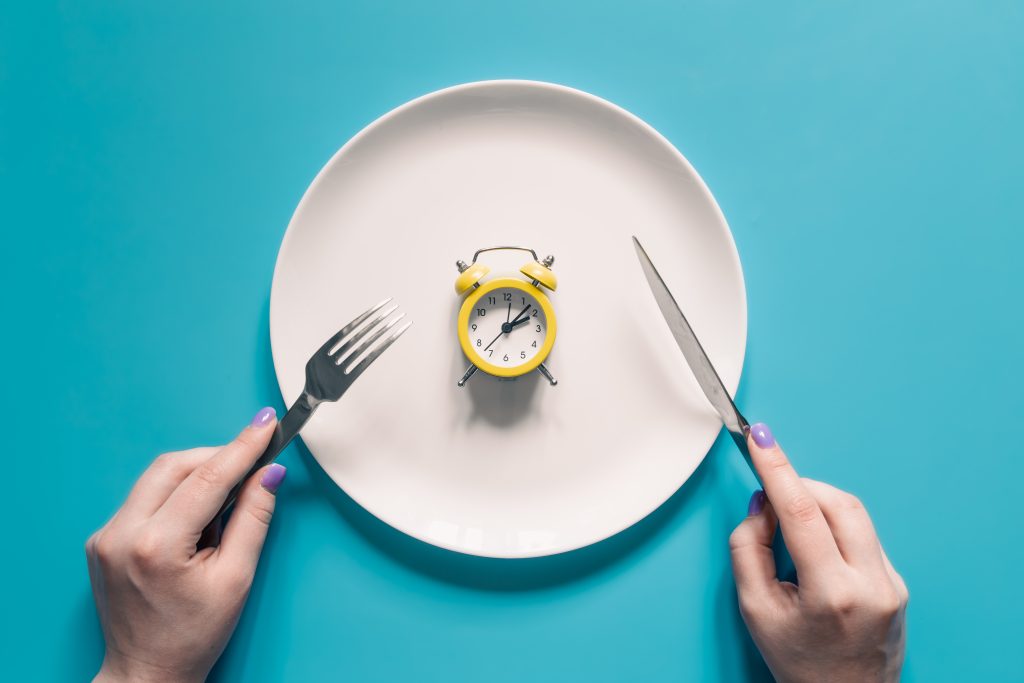Intermittent Fasting (IF) is an Eating Pattern
Intermittent Fasting (IF) is an eating plan that switches between eating and fasting windows on a regular basis. Compared to calorie-restricted (CR) diets, which focus on WHAT to eat, IF focuses on WHEN to eat. IF is NOT just another diet. Traditional diet programs reduce your calorie intake and make you feel hungry all the time. This is the main reason most diet programs fail. However, IF taps into fat as the alternative (and better!) energy source, reducing food cravings once your body adapts. Many fasters stick to IF once they become accustomed to the new eating habit and they are able to enjoy long-term health benefits as a result.
How Does IF Work?
Here are a few helpful diagrams that explain how IF switches the body to different states and burns stored fat.
-
Fed State:
When we consume food, glucose from carbohydrates is broken down and used by our organs as a major source of energy. Excessive glucose is stored for later use in the liver and tissue in the form of glycogen and fat[1].

-
Fasting State I (0-12 hours after eating):
Glycogen is converted back into energy by the liver to keep on supplying energy to our bodies. Typically, the stored glycogen can provide energy to an average person for a good 10 to 12 hours, but a person who exercises might run out of the stored glycogen in much less time [2].

-
Fasting State II (no food after 12-14 hours)
Once the reserve of glycogen in the liver is depleted, the body taps into energy stores. Fats are broken down into free fatty acids which are then converted into additional metabolic fuel called ketones in the liver. Thus, if the fasting state is prolonged, the body burns fat for energy and loses more of it [3].

Will IF Cause Starvation or Malnutrition?
As mentioned earlier, IF helps your body use fat as an alternative energy source. As a result, intermittent fasting will not starve your body. You may feel hungry at times when you are adjusting to the new eating pattern (for example, from eating 3 meals to 2.5 meals and then to 2 meals, etc). However, whether it’s from food intake or stored fat, you should always have the calories your body needs to keep from starving. Our FastingQueens app is designed to help you monitor your body’s reactions so you can ease into the journey safely and comfortably.
IF also allows you to take in sufficient daily calories and nutrients during the eating window, so a well-planned IF lifestyle will not lead to malnutrition [4]. Be sure to eat enough protein and good fat during your eating windows.
We are Here to Help
There are many articles and recipes available on our FastingQueens app and website to help you eat nutritious food. We also provide a fasting tracker and a period tracker which will help you monitor your IF journey and make sure you’re doing it safely. You can rest assured that you will receive all the health benefits you’ve been dreaming of.
References:
- Harvey RA, Ferrier DR. Biochemistry. Lippincott Williams & Wilkins; 2011. Link
- Jensen TE, Richter EA. Regulation of glucose and glycogen metabolism during and after exercise. The Journal of Physiology. 2012 Mar 1;590(5):1069-76. Link
- Smyers ME, Koch LG, Britton SL, Wagner JG, Novak CM. Enhanced weight and fat loss from long-term intermittent fasting in obesity-prone, low-fitness rats. Physiology & Behavior. 2021 Mar 1;230:113280. Link
- Duregon E, Pomatto-Watson LC, Bernier M, Price NL, de Cabo R. Intermittent fasting: from calories to time restriction. Geroscience. 2021 Jun;43(3):1083-92. Link

